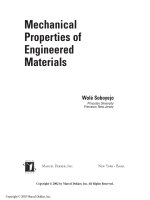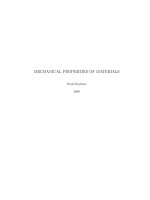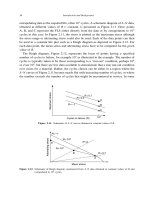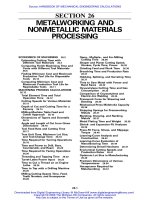Mechanical Properties of Engineered Materials 2008 Part 6 docx
Bạn đang xem bản rút gọn của tài liệu. Xem và tải ngay bản đầy đủ của tài liệu tại đây (468.4 KB, 29 trang )
5
IntroductiontoPlasticity
5.1INTRODUCTION
Afterahighenoughstressisreached,thestrainnolongerdisappearsonthe
releaseofstress.Theremainingpermanentstrainiscalleda‘‘plastic’’strain
(Fig.5.1).Additionalincrementalplasticstrainsmayalsobeaccumulated
onsubsequentloadingandunloading,andthesecanleadultimatelyto
failure.Insomecases,thedimensionalandshapechangesassociatedwith
plasticitymayleadtolossoftolerance(s)andprematureretirementofa
structureorcomponentfromservice.Anunderstanding ofplasticityis,
therefore,importantinthedesignandanalysisof engineeringstructures
andcomponents.
Thischapter presentsabasicintroductiontothemechanismsand
mechanicsofplasticityinmonolithicmaterials.Following a simple review
of the physical basis for plasticity in different classes of monolithic materials
(ceramics, metals, intermetallics, and polymers), empirical plastic flow rules
are introduced along with multiaxial yield criteria. Constitutive equations of
plasticity are then presented in the final section of the chapter.
Copyright © 2003 Marcel Dekker, Inc.
5.2PHYSICALBASISFORPLASTICITY
5.2.1PlasticityinCeramics
Mostceramicsonlyundergoonlyelasticdeformationpriortotheonsetof
catastrophicfailureatroomtemperature.Hence,mostreportsonthe
mechanicalpropertiesofceramicsareoftenlimitedtoelasticproperties.
Furthermore,mostceramistsreportflexuralpropertiesobtainedunder
three-orfour-pointbending.Typicalstrengthpropertiesofselectedceramic
materialsarepresentedinTable5.1.Notethatceramicsarestronger(almost
15 times stronger) in compression than in tension. Also, the flexural
strengths are intermediate between the compressive and tensile strength
levels. Reasons for these load-dependent properties will be discussed in
subsequent chapters. For now, it is simply sufficient to state that the trends
are due largely to the effects of pre-existing defects such as cracks in the
ceramic structures.
The limited capacity of ceramic materials for plastic deformation is
due largely to the limited mobility of dislocations in ceramic structures. The
latter may be attributed to their large Burgers (slip) vectors and unfavorable
(for plastic deformation) ionically/covalently bonded crystal structures.
Plastic deformation in ceramics is, therefore, limited to very small strains
(typically < 0.1–1%), except at elevated temperatures where thermally acti-
vated dislocation motion and grain boundary sliding are possible. In fact,
the extent of plasticity at elevated temperatures may be very significant in
FIGURE 5.1 Schematic illustration of plastic strain after unloading.
Copyright © 2003 Marcel Dekker, Inc.
ceramicsdeformedatelevatedtemperature,andsuperplasticity(strainlevels
upto1000%plasticstrain)hasbeenshowntooccurduetocreepphenom-
enainsomefine-grainedceramicsproduced.
However,inmostceramics,theplasticstrainstofailurearerelatively
small(<1%),especiallyundertensileloadingwhichtendstoopenuppre-
existingcracksthataregenerallypresentafterprocessing.Also,sinceinci-
pientcracksinceramicstendtocloseupundercompressiveloading,the
strengthlevelsandthetotalstraintofailureincompressionareoftengreater
thanthoseintension.Furthermore,verylimitedplasticity(permanent
strainsonremovalofappliedstresses)mayoccurinsomeceramicsorcera-
micmatrixcompositesbymicrocrackingorstress-inducedphasetransfor-
mations.
MicrocrackinggenerallyresultsinareductioninYoung’smodulus,E,
whichmaybeusedasaglobal/scalarmeasureofdamage(Fig.5.2).Ifwe
assume that the initial ‘‘undeformed’’ material has a damage state of zero,
while the final state of damage at the point of catastrophic failure corre-
sponds to a damage state of 1, we may estimate the state of damage using
some simple damage rules. For an initial Young’s modulus of E
0
and an
intermediate damage state, the damage variable, D, is given simply by
D ¼ 1 ÀE=E
0
. Damage tensors may also be used to obtain more rigorous
descriptions of damage (Lemaitre, 1991).
Plasticity in ceramics may also occur by stress-induced phase transfor-
mations. This has been observed in partially stabilized zirconia (ZrO
2
alloyed with CaO, Y
2
O
3,
or CeO to stabilize the high-temperature tetragonal
TABLE 5.1 Strength Properties of Selected Ceramic Materials
Material
Compressive
strength
(MPa (ksi)]
Tensile
strength
[MPa (ksi)]
Flexural
strength
[MPa (ksi)]
Modulus of
elasticity
[GPa (10
6
psi)]
Alumina (85% dense) 1620 (235) 125 (18) 295 (42.5) 220 (32)
Alumina (99.8% dense) 2760 (400) 205 (30) 345 (60) 385 (56)
Alumina silicate 275 (40) 17 (2.5) 62 (9) 55 (8)
Transformation
toughened zirconia
1760 (255) 350 (51) 635 (92) 200 (29)
Partially stabilized
zirconia þ9% MgO
1860 (270) — 690 (100) 205 (30)
Cast Si
3
N
4
138 (20) 24 (3.5) 69 (10) 115 (17)
Hot-pressed Si
3
N
4
3450 (500) — 860 (125) —
Sources: After Hertzberg, 1996. Reprinted with permission from John Wiley.
a
Guide to Engineering Materials. vol. 1(1). ASM, Metals Park, OH, 1986, pp 16, 64, 65.
Copyright © 2003 Marcel Dekker, Inc.
phasedowntoroomtemperature).Undermonotonicloading,themeta-
stabletetragonalphasecanundergostress-inducedphasetransformations
fromthetetragonaltothemonoclinicphase.Thisstress-inducedphase
transformationisassociatedwithavolumeincreaseof$4%,andcan
giverisetoaformoftougheningknownastransformationtoughening,
whichwillbediscussedinCh.13.
Stress-inducedphasetransformationsoccurgraduallyinpartiallysta-
bilizedzirconia,andtheygiverisetoagradualtransitionfromlinearityin
theelasticregime,tothenonlinearsecondstageofthestress–straincurve
showninFig.5.3.Thesecondstageendswhenthestress-inducedtransfor-
mationspreadscompletelyacrossthegaugesectionofthespecimen.Thisis
followedbythefinalstageinwhichrapidhardeningoccursuntilfailure.Itis
importanttonotethatthetotalstraintofailureislimited,eveninpartially
stabilizedzirconiapolycrystals.Also,asinconventionalplasticity,stress-
inducedtransformationmaybeassociatedwithincreasing,level,ordecreas-
ingstress–strainbehavior(Fig5.4).
5.2.2PlasticityinMetals
Incontrasttoceramics,plasticdeformation inmetalsistypicallyassociated
withrelativelylargestrainsbeforefinalfailure.ThisisillustratedinFig.5.5
usingdataobtained foranaluminumalloy.Ingeneral,thetotalplastic
strainscanvarybetween5and100%inductilemetalsdeformedtofailure
at room temperature. However, the elastic portion of the stress–strain curve
is generally limited to strains below $ 0:1 to 1%. Furthermore, metals and
their alloys may exhibit stress–strain characteristics with rising, level, or
FIGURE5.2Schematicshowingthechangeinmodulusdue to damage during
loading and unloading sequences.
Copyright © 2003 Marcel Dekker, Inc.
decreasing stress, as shown in Fig. 5.4. Materials in which the stress level
remains constant with increasing strain [Fig. 5.4(b)] are known as elastic–
perfectly plastic. Materials in which the stress level decreases with increasing
strain are said to undergo strain softening [Fig. 5.4(c)], while those in which
the stress level increases with increasing strain are described as strain hard-
ening materials, Fig. 5.4(a).
FIGURE 5.3 Schematic of the three stages of deformation in material under-
going stress-induced phase transformation. (After Evans et al., 1981.)
FIGURE 5.4 Types of stress–strain response: (a) strain hardening; (b) elastic–
perfectly plastic deformation; (c) strain softening.
Copyright © 2003 Marcel Dekker, Inc.
Strainhardeningoccursasaresultofdislocationinteractionsinthe
fullyplasticregime.Thesemayinvolveinteractionswithpointdefects
(vacancies,interstitials,orsolutes),linedefects(screw,edge,ormixeddis-
locations),surfacedefects(grainboundaries,twinboundaries,orstacking
faults),andvolumedefects(porosity,entrappedgases,andinclusions).The
dislocationinteractionsmaygiverisetohardeningwhenadditionalstresses
mustbeappliedtoovercometheinfluenceofdefectsthatrestrictdislocation
motion.Thismayresultinrisingstress–straincurvesthatarecharacteristic
ofstrainhardeningbehavior,Fig.5.4(a).
Asdiscussedearlier,thestress–straincurvesmayalsoremainlevel
[Fig.5.4(b)],ordecreaseorincreasecontinuouslywithincreasingstrain,
Fig.5.4(c).Thereasonsforsuchbehavioraregenerallycomplex,andnot
fullyunderstoodatpresent.However,thereissomelimitedevidencethat
suggeststhatelastic–perfectlyplasticbehaviorisassociatedwithslipplanar-
ity,i.e.,sliponaparticularcrystallographicplane,whilestrainsoftening
tendstooccurincaseswheresliplocalizesonaparticularmicrostructural
featuresuchasaprecipitate.Theonsetofmacroscopicyielding,therefore,
correspondstothestressneededtoshearthemicrostructuralfeature.Once
theinitialresistancetoshearisovercome,thematerialmayofferdecreasing
resistancetoincreasingdisplacement,givingriseultimatelytostrainsoft-
eningbehavior,Fig.5.4(c).
Sincethemovingdislocationsinteractwithsoluteclouds,serrated
yieldingphenomenamaybeobservedinthestress–strainbehavior[Fig
5.6).Differenttypesofserratedyieldingphenomenahavebeenreported
due to the interactions of dislocations with internal defects such as solutes
and interstitials. The phenomenon is generally referred to as the Portevin–
FIGURE 5.5 Stress–strain behavior in an aluminum alloy. (After Courtney,
1990. Reprinted with permission from McGraw-Hill.)
Copyright © 2003 Marcel Dekker, Inc.
LeChateliereffect,inhonorofthetwoFrenchmenwhofirstreportedit
(PortevinandLeChatelier,1923).Theserrationsarecausedbythepinning
andunpinningofgroupsofdislocationsfromsolutesthatdiffusetowardsit
asitmovesthroughalattice.Themechanismsisparticularlyeffectiveat
particularparametricrangesofstrain-rateandtemperature(Cottrell,1958).
Finallyinthissection,itisimportanttodiscusstheso-calledanom-
alousyieldphenomenathathasbeenreportedinsomeplaincarbonsteels
(Fig.5.7).Thestress–strainplotsforsuchmaterialshavebeenobservedto
exhibit double yield points in some annealed conditions, as shown in Fig.
5.7. The upper yield point (UYP) corresponds to the unpinning of disloca-
tions from interstitial carbon clouds. Upon unpinning, the load drops to a
lower yield point (LYP). Lu
¨
der’s bands (shear bands inclined at $ 458
degrees to the loading axis) are then observed to propagate across the
FIGURE 5.6 Types of serrated yielding phenomena: (a) Type A; (b) Type B; (c)
Type C; (d) Type S. (Types A–C After Brindley and Worthington, 1970; Type S
After Pink, 1994. Reprinted with permission from Scripta Met.)
Copyright © 2003 Marcel Dekker, Inc.
gaugesectionsofthetensilespecimens,asthestrainisincreasedfurther
(Fig.5.7).Notethatthestressremainsrelativelyconstantintheso-called
Lu
¨
der’sstrainregime,althoughserrationsmaybeobservedwithsufficiently
sensitiveinstrumentation.Thestrainattheendofthisconstantstressregime
isknownastheLu
¨
dersstrain.Thiscorrespondstothepointatwhichthe
Lu
¨
der’sbandshavespreadcompletelyacrossthegaugesectionofthespeci-
men.Beyondthispoint,thestressgenerallyincreaseswithincreasingdueto
themultipleinteractionsbetweendislocations,asdiscussedearlierforcon-
ventionalmetallicmaterials(Fig.5.5).
5.2.3PlasticityinIntermetallics
AsdiscussedinChap.1,intermetallicsarecompoundsbetweenmetalsand
other metals.Duetotheirgenerallyordered structures,andpartiallycova-
lentlyor ionicallybondedstructures,intermetallics generally exhibit only
limited plasticity at room-temperature. Nevertheless, some ductility has
been reported for ordered gamma-based titanium aluminide intermetallics
FIGURE5.7Anomalousyieldingin1018 plaincarbonsteel.(After Courtney,
1990. Reprinted with permission from McGraw-Hill.)
Copyright © 2003 Marcel Dekker, Inc.
withduplex
2
þmicrostructures.Thesetwophaseintermetallicshave
roomtemperatureplasticelongationstofailureofabout1–2%duetodefor-
mationbyslipandtwinning(KimandDimiduk,1991).Theirlimitedroom-
temperatureductilityhasbeenattributedtothesoakingupofinterstitial
oxygenbythe
2
phase.Thisresultsinareductionininterstitialoxygen
contentinthegammaphase,andtheincreaseddislocationmobilityofdis-
locationsinthelatterwhichgivesrisetotheimprovedductilityintwo-phase
gammatitaniumaluminides(Vasudevanetal.,1989).
Niobiumaluminideintermetallicswithplasticelongationsof10–30%
havealsobeendevelopedinrecentyears(Houetal.,1994;Yeet.al.,1998).
TheductilityintheseB2(orderedbody-centeredcubicstructures)interme-
tallicshasbeenattributedtothepartialorderintheirstructures.Similar
improvementsinroom-temperature(10–50%)ductilityhavebeenreported
inNi
3
Alintermetallicsthatarealloyedwithboron(AokiandIzumi,1979;
Liuetal.,1983),andFe
3
Alintermetallicsalloyedwithboron(Liuand
Kumar,1993).
Theimprovementsintheroom-temperatureductilitiesofthenickel
andironaluminideintermetallicshavebeenattributedtothecleaningupof
thegrainboundariesbytheboronadditions.However,thereasonsforthe
improvedductilityinorderedorpartiallyorderedintermetallicsarestillnot
fullyunderstood,andareunderinvestigation.Similarly,anomalousyield-
pointphenomena(increasingyieldstresswithincreasingtemperature)and
thetransitionfrombrittlebehavioratroomtemperaturetoductilebehavior
atelevatedtemperaturearestillunderinvestigation.
5.2.4PlasticityinPolymers
Plasticityinpolymersisnotcontrolledbydislocations,althoughdisloca-
tionsmayalsoexistinpolymericstructures.Instead,plasticdeformationin
polymersoccurslargelybychainsliding,rotation,andunkinking(Figs1.7
and1.8).Suchchainslidingmechanismsdonotoccursoreadilyinthree-
dimensional(thermoset)polymers(Fig.1.8).However,chainslidingmay
occurrelativelyeasilyinlinear(thermoplastic)polymerswhentheslidingof
polymerchainsisnothinderedsignificantlybyradicalsidegroupsorother
sterichindrances.Theplasticdeformationofpolymersisalsoassociated
withsignificantchangesinentropy,whichcanalterthelocaldrivingforce
fordeformation.
Elasticityandplasticity[Fig.5.8(a)]inrubberypolymersmayresultin
strainlevelsthatarebetween 100and1000%atfracture.Such largestrains
areassociatedwithchainsliding, unkinking,anduncoilingmechanisms.
Furthermore, unloading does not result in a sudden load drop. Instead,
unloading follows a time-dependent path, as shown in Fig. 5.8(b).
Copyright © 2003 Marcel Dekker, Inc.
Elasticityandplasticityinrubberypolymersare,therefore,oftentime
dependent,sincetimeisoftenrequiredforthepolymerchainstoflowto
andfromthedeformedconfigurations.Cyclicdeformationmayresultin
hysterisisloopssincethestraingenerallylagsthestress(Fig.5.9),and
anomalousstress–strainbehaviormayalsobeassociatedwithchaininter-
actionswithdistributedsidegroupswhichareoftenreferredtoassteric
hindrances.
Crystallinepolymers(Fig.1.9)mayalsoexhibitinterestingstress–
strainbehavior.Theminimuminthestress–straincurveisduetocold
drawingandthecompetitionbetweenthebreakdownoftheinitialcrys-
tallinestructure,andthereorganizationintoahighlyorientedchain
structure.
5.3ELASTIC–PLASTICBEHAVIOR
AgenericplotofstressversusstrainispresentedinFig.5.10.Thisshowsa
transitionfromalinear‘‘elastic’’regimetoanonlinear‘‘plasticregime.’’
Thelinearelasticregimepersistsuptotheproportionallimit,atwhichthe
deviationfromlinearelasticbehavioroccurs.However,theonsetofnon-
linearstress–strainbehaviorisgenerallydifficulttodetermineexperimen-
tally.Anengineeringoffsetyieldstrengthis,therefore,definedbydrawinga
lineparalleltotheoriginallinearelasticline,butoffsetbyagivenstrain
(usuallyanengineeringstrainlevelof0.002or0.2%).
FIGURE5.8Elastic–plasticdeformationinrubberypolymers.(a)Rubberrand
deformed at room temperature. (After Argon and McClintock, 1990) (b)
Viscoelasticity in a rubbery polymer. (After Hertzberg, 1996. Reprinted with
permission from John Wiley.)
Copyright © 2003 Marcel Dekker, Inc.
The arbitrary offset strain level of 0.002 is recommended by the ASTM
E-8 code for tensile testing for the characterization of stresses required for
bulk yielding. However, it is important to remember that the offset strain
level is simply an arbitrary number selected by a group of experts with a
considerable amount of combined experience in the area of tensile testing.
Above the offset yield strength, A, the stress may continue to increase
with increasing applied strain. The slope of the stress–strain curve in the
FIGURE 5.9 Hysterisis loop in a cyclically deformed polymer.
FIGURE 5.10 Schematic of stress–strain behavior in the elastic and plastic
regimes.
Copyright © 2003 Marcel Dekker, Inc.
plasticregimedependslargelyontheunderlyingdislocationinteractions.
Theresultingshapechangesinthegaugesectionsoftensilespecimensare
illustratedinFig.5.11.Stretchingintheverticaldirectionisaccompaniedby
Poissoncontractionintheelasticregime.However,thecontractioninthe
horizontaldirectioniscounteredbyhardeningduringtheinitialstagesof
plasticdeformationinwhichthegaugesectiondeformsinarelativelyuni-
formmanner,Fig.5.12(a).Therateofrateofhardeningis,therefore,
greater than the rate of horizontal contraction, and the total volume of
deformed material remains constant, Fig. 5.12(a). This inequality persists
until the ultimate tensile strength, M, is reached in Fig. 5.11. At this stress
level, the rate of hardening is equal to the rate contraction of the gauge area,
as shown in Fig. 5.12(b).
Beyond the point M, in the stress–strain plot, geometrical instabilities
(internal microvoids and microcracks within the gauge section) dominate
the plastic response, and the rate of horizontal contraction is greater than
the rate of hardening, Fig. 5.12(c). The deformation is thus concentrated
within regions with the highest crack/microvoid density, and a phenomenon
known as ‘‘necking’’ [Figs 5.11 and 5.12(c)] occurs beyond the ultimate
FIGURE 5.11 Schematic illustration of gauge deformation in the elastic and
plastic regimes.
Copyright © 2003 Marcel Dekker, Inc.
tensilestress.Thisinvolvesthegradualreductioninthecross-sectionalarea
intheregimeofconcentrateddeformation.Thisreductionoccursbecauseof
therateofhorizontalcontractionisnowgreaterthantherateofhardening,
Fig.5.12(c).Neckingmaycontinueuntilthegeometricalinstabilitiescoa-
lesce.Inanycase,catastrophicfailureoccurswhenacriticalconditionis
reached.
Itisimportanttonoteherethattheonsetofneckingmaybedelayed
bytheapplicationofhydrostaticstressestothegaugesectionofatensile
specimen.ThiswasfirstshownbyBridgman(1948)whodemonstratedthat
theductilityofmetalscouldbeincreasedsignificantlywithincreasinghydro-
staticstress.Thisisbecausethehydrostaticstressestendtocloseuppores
andvoidsthatleadultimatelytoneckingandfracture.
Thegeometricalinstabilitiesare,therefore,artifactsofthetestcondi-
tionsandspecimengeometriesthatareusedintensiletests(Fig5.13).Note
thatthetensilespecimengeometries(usuallydog-boneshapes)aretypically
designedtominimizestressconcentrationsintheregionoftransitionfrom
thegriptothegaugesections.Thisisdonetoavoidfractureoutsidethe
FIGURE5.12Hardeningversusgeometricalinstability:(a)rateofhardening>
rate of geometrical instability formation; (b) rate of hardening ¼ rate of geo-
metrical instability formation (onset of necking); (c) rate of hardening < rate of
geometrical instability formation (necking down to failure) (After Courtney,
1990. Reprinted with permission from McGraw-Hill.)
Copyright © 2003 Marcel Dekker, Inc.
gaugesection.Also,theengineeringdefinitionsofstressandstrainmaynot
beapplicabletosituationsinwhichthecross-sectionalareachangessignifi-
cantlyduringincrementalplasticdeformationtofailure(Figs5.11and5.12).
Truestressandtruestrainlevelsmust,therefore,bedefined,especially
intheplasticregime.Thetrueengineeringstress,
T
,isgivenbytheratioof
appliedload,P,totheactualcross-sectionalarea,A.Thisgives
FIGURE5.13Typesoftensilespecimengeometries:(a)cylindricalcross
sections, (b) dog-bone specimen (wedge grips); (c) dog-bone specimen (pin
loaded).
Copyright © 2003 Marcel Dekker, Inc.
T
¼ True stress ¼
Applied load
Actual cross-sectional area
¼
P
A
ð5:1Þ
In contrast, the engineering stress,
E
, is given simply by the ratio of applied
load, P, to the original cross-sectional area, A
0
. This gives
E
¼ Engineering stress ¼
Applied load
Original cross-sectional area
¼
P
A
0
ð5:2Þ
Similarly, the engineering strain levels a re different from the true strain
levels which are known to increase in an incremental manner. The true
strain, "
T
, is obtained from the incremental theory of plasticity by separating
the total displacement into incremental portions. This gives
"
T
¼
X
n
i¼ 1
d‘
i
‘
j
ð5:3Þ
where d‘
i
is the increment in specimen length that occurs during the ith
deformation stage, and n is the number of incremental deformation stages.
In the limit, Eq. (5.3) may be expressed in integral form, which gives
"
T
¼
ð
‘
‘
0
d‘
‘
¼ ln
‘
‘
0
ð5:4Þ
where ‘ is the actual instantaneous (deformed) length, ‘
0
is the initial
(undeformed) length, and ln denotes natural logarithms. The true strain
is, therefore, different from the engineering strain, "
E
, which is given simply
by the ratio of the change in gauge length, ‘ ¼ ‘ À‘
0
, to the original
(undeformed) length, ‘
0
:
"
E
¼
‘
‘
0
¼
‘ À‘
0
‘
0
ð5:5Þ
Furthermore, since the deformed volume remains constant during
plastic deformation, the initial volume of the gauge section before plastic
deformation must be equal to the final volume of the gauge section during
plastic deformation. If the initial (undeformed) gauge cross-sectional area is
A
0
and the deformed cross-sectional area is A (during plastic deformation),
then the initial volume ðA
0
‘
0
Þ and the deformed volume (A‘) must be the
same. Hence, the area ratio, A
0
=A, must be equal to the length ratio, ‘=‘
0
.
The equations for engineering strain and true strain (Equations (5.4) and
(5.5)] may, therefore, be expressed as
Copyright © 2003 Marcel Dekker, Inc.
"
E
¼
‘
‘
0
À‘¼
A
0
A
À‘ð5:6Þ
and
"
T
¼1n
‘
‘
0
¼1n
A
0
A
¼1nð‘þ"
E
Þð5:7Þ
Similarly,thetruestress,
T
,maybeexpressedintermsoftheengineering
stresssince
T
¼
P
A
¼
P
A
0
Á
A
0
A
¼
E
A
0
A
¼
E
1
1
0
¼
E
ð1þ"
E
Þð5:8Þ
Itisimportanttonoteherethatalloftheabovedefinitionsoftrue
stressandtruestrainarevalidforstresslevelsbeloworequaltotheultimate
tensilestrength(themaximumengineeringstress)intheplotofengineering
stressversusengineeringstrain(Fig.5.11).However,duetotheeffectsof
geometricalinstabilities(Fig.5.12),theexpressionsinvolvingthegauge
lengthtermsshouldnotbeusedintheregimebeyondtheultimatetensile
strength.Thisisbecausethecross-sectionalareasdecreasebyneckingin
areaswiththegreatestconcentrationsofgeometricalinstabilities.Area
ratiosshould,therefore,beusedinthedeterminationoftruestressand
truestrainlevelsfordeformationbeyondtheultimatetensilestrength.
Acharacteristicplotoftruestressversustruestrainiscomparedwitha
typicalengineeringstress–strainplotinFig.5.14.The‘‘true’’stress–strain
plot obtained from length ratios is shown in solid lines, while the true stress–
strain plot obtained from area ratios is represented by the dashed lines in
Fig. 5.14. The two plots are coincident until the ultimate tensile stress is
reached. Note also that the true stress–strain plots are shifted to the top and
to the left of the original points on the engineering stress–strain plots (Fig.
5.14). Also, there is no indication of an ultimate tensile strength on the true
stress–strain plot. This is because the ultimate tensile strength is purely a test
artifact that is due to the presence of geometrical instabilities within a test
specimen.
As discussed earlier, the smooth parabolic stress–strain curves
observed in the plasticity regime are generally associated with the bulk/
irreversible movement of dislocations in metals and intermetallics. The plas-
tic stress–strain curves may also be associated with chain sliding and chain
uncoiling/unkinking processes in noncrystalline polymers. In any case, the
slope in the rising portion of the plastic stress–strain plots is a measure of
resistance to plastic deformation (Fig. 5.11). The material is said to undergo
strain hardening in this regime (Fig. 5.11).
Copyright © 2003 Marcel Dekker, Inc.
Itisimportanttonotehere,however,thatsomematerialsdonot
undergoanystrainhardening.Incaseswhereconstantstresslevelsare
requiredtocontinuetheplasticstraining,thematerialsaredescribedas
perfectlyplasticmaterials,Fig.5.4(b).Incontrast,strainsofteningoccurs
whenthestressrequiredfordeformationdecreaseswithincreasingstrain,
Fig.5.4(c).Inmostmaterials,however,theportionofthestressstraincurve
betweentheonsetofbulkyielding(bulkyieldstress)andtheonsetof
necking(theultimatetensilestress)tendstoexhibitthetypeofrising
stress–strainbehaviorshowninFig.5.4(a).
5.4EMPIRICALSTRESS–STRAINRELATIONSHIPS
Itiscurrentlyimpossibletodevelopabinitiomethodsforthepredictionof
thestress–strainbehaviorofmaterialsfromdetaileddescriptionsofthe
underlyingatomicanddefectstructures.However,someusefulempirical
relationshipshavebeendevelopedforthecharacterizationofthetrue
stress–strainbehavior.Themostpopularempiricalmathematicalrelation-
shipisusuallyattributedtoHollomon(1945),althoughitwasfirstproposed
byBu
¨
lfinger(1735)about200yearsearlier.Theso-calledHollomonequa-
tionisgivenby
¼Kð"Þ
n
ð5:9Þ
FIGURE5.14Comparisonoftruestress–strainbehaviorwithengineering
stress–strain behavior.
Copyright © 2003 Marcel Dekker, Inc.
where is the true stre ss, K is a proportionality constant that represents the
true stress at a true strain of 1.0, and n is the strain hardening/work hard-
ening exponent which is a measure of the resistance to plastic deformation.
In general, the strain hardening, n, is a number between 0 and 1. Also, n is
sensitive to thermomechanical processing and heat treatment, and it is gen-
erally higher in materials tested in the annealed or hot worked conditions.
Strain hardening exponents for selected materials are presented in Table 5.2.
Such data may be obtained readily from log–log plots of true stress versus
true strain. Taking logarithms of Eq. (5.9) gives
log ¼ log k þ n log " ð5:10Þ
Equation (5.10) is the equation of a straight line, with a slope of n, and
a y axis intercept of log K. Hence, from Eq. (5.10), the material constants K
and n may be obtained from the intercept and slope, respectively, of a plot
of log versus log ". However, it is important to note that the straight-line
relationship suggested by Eq. (5.10) is not always followed by every mate-
rial. Error analysis must, therefore, be performed to determine the applic-
ability of the Hollomon equation. Also, in several materials, the hardening
coefficient, n, is often found empirically to be approximately equal to the
true strain at the ultimate tensile strain. This is referred to as the Considere
criterion, and it may be derived simply by noting that P ¼ A, and finding
the condition for which dP ¼ dA þAd ¼ 0 (see Sect. 5.5). In any case, it
is important to remember that the applicability of the Considere criterion
must be verified by appropriate error analysis.
In general, however, the strain hardening exponent of a metallic mate-
rial increases with increasing strength and decreasing dislocation mobility.
The stress–strain behavior of a material may also be significantly affected by
TABLE 5.2 Strain Hardening Exponents
of Selected Metallic Materials
Material
Strain hardening
coefficient, n
Stainless steel 0.45–0.55
Brass 0.35–0.4
Copper 0.3–0.35
Aluminum 0.15–0.25
Iron 0.05–0.15
After Hertzberg, 1996. Reprinted with
permission from John Wiley.
Copyright © 2003 Marcel Dekker, Inc.
thestrain-rate,
_
""¼d"=dt.Theeffectsofstrainratecanbemodeledusingthe
followingempiricalpowerlawequation:
¼K
0
ð
_
""Þ
m
ð5:11Þ
whereisthetruestress,
_
""isthetruestrain-rate,K
0
isaproportionality
constantcorrespondingtothestressforastrain-rateof1s
–1
,andmisthe
strain-ratesensitivityfactorwhichcanhavevaluesbetween0and1.Asfor
thestrainhardeningexponent,thestrain-ratesensitivitycanbedetermined
fromlog–logplotsofstressversus
_
"".Materialswithstrain-ratesensitivity
factorsbetween0and0.1arenotstrain-ratesensitive,whilematerialswith
strain-ratesensitivitiesbetween0.5and1areverystrain-ratesensitive.
Mostmaterialshavestrain-ratesensitivityvaluescloseto0.2.
However,verystrain-ratesensitivematerialssuchas‘‘sillyputty’’may
havestrain-ratesensitivityvaluescloseto1.Suchmaterialsareresistant
tofractureduetonecking.Theymay,therefore,deformextensivelyby
neckingdowntoapoint.Thisisbecausetherateofhardeningathigh
strain-ratestendstopreventtheonsetofnecking.Inthemostextreme
cases,thisleadstosuperplasticbehaviorwhichisassociatedwithextremely
highplasticstrainlevelsbetween100and1000%.Highvaluesofthestrain-
ratesensitivityindex,m,are,therefore,oneindicationofthepotentialfor
superplasticity.
Finallyinthissection,itisofinteresttonotethatthecombinedeffects
ofstrain-ratesensitivityandstrainhardening(onthetruestress)canbe
assessedusingthefollowingequationwhichisobtainedbycombiningEqs
(5.9)and(5.11).Thisgives
¼K
00
ð"Þ
n
ð
_
""Þ
m
ð5:12Þ
whereisthetruestress,andK
00
isaproportionalityconstantwhichis
relatedtothematerialconstants,KandK
0
.Thevariable,",isthetrue
plasticstrain,nisthestrainhardeningexponent,
_
""isthestrain-rate,and
misthestrain-ratesensitivity.Asbefore,theproportionalityconstantsmay
bedeterminedformappropriatelog–logplots.Notethateitherstrain,",or
strain-rate,
_
"",maybevariedindependentlyorsimultaneouslyinEq.(5.12).
TheapplicabilityofEq.(5.12)mustalsobeestablishedbycomparingpre-
dictedtruestresseswithactualtruestressesobtainedforeachmaterial,i.e.,
erroranalysismustbeperformedtodeterminetheapplicabilityofEq.
(5.12).
Tensilepropertiesforsomecommonengineeringmaterialsarepre-
sentedinTable5.3.Notethatthedatapresentedinthislattertableare
verydependentonmicrostructureandcomposition.Theeffectsofthese
variablesonyieldstrengthwillbediscussedindetailinChap.7.Fornow,
Copyright © 2003 Marcel Dekker, Inc.
itissimplysufficienttonotethattensilestrengthgenerallyincreaseswith
decreasinggrainsize.
5.5CONSIDERECRITERION
AsstatedinSect.5.4,theConsiderecriterionmaybederivedbyconsidering
theconditionsthatmustbesatisfiedattheultimatetensilestrength(Fig.
5.11).Theultimatetensilestrengthcorrespondstothemaximumvalueof
load, P, in the plot of load ve rsus strain. Since P ¼ A, the maxi mum value
of P may be obtained by equating the first derivative, dP, to zero. This gives
dP ¼ Ad þ dA ¼ 0 ð5:13Þ
Rearranging Eq. (5.13) and separating variables gives
À
dA
A
¼
d
ð5:14Þ
Since there is no change in volume, V ¼ A‘, associated with plastic defor-
mation, we may also assume that dV ¼ 0. Hence,
dV ¼ Ad‘ þ ‘dA ¼ 0 ð5:15Þ
Rearranging Eq. (5.15) and separating variables, we obtain:
À
dA
A
¼
d‘
‘
¼ d" ð5:16Þ
If we now assume that the Hollomon equation can be used to describe the
stress–strain response, i.e., ¼ K"
n
, then d, obtained by differentiating Eq.
(5.9), is given by
d ¼ Kn"
nÀ1
d" ¼ nðK "
n
Þ"
À1
d" ¼ n"
À1
d" ð5:17Þ
Also, substituting Eqs (5.14) and (5.16) into Eq. (5.17) yields:
d" ¼
n"
À1
d"
ð5:18aÞ
or
n ¼ " ð5:18bÞ
Equation 5.18(b) is often referred to as the Considere criterion. It states
that the strain at the onset of necking is equal to the stra in hardening expo-
nent. It is a very useful ‘‘rule-of-thumb.’’ It is important to remember that
the Considere criterion is only applicable when Hollomon’s equation can be
used to describe the stress–strain behavior of a material.
Copyright © 2003 Marcel Dekker, Inc.
TABLE 5.3 Tensile Properties of Selected Engineering Materials
Material Treatment
Yield
strength
(MPa)
Tensile
strength
(MPa)
Elongation
in 5-cm
gauge (%)
Reduction
in area
(1.28 cm
diameter)
(%)
Steel alloys
1015 As-rolled 315 420 39 61
1050 As-rolled 415 725 20 40
1080 As-rolled 585 965 12 17
1340 Q þ T (2058C) 1590 1810 11 35
1340 Q þ T (4258C) 1150 1260 14 51
1340 Q þ T (6508C) 620 800 22 66
4340 Q þ T (2058C) 1675 1875 10 38
4340 Q þ T (4258C) 1365 1470 10 44
4340 Q þ T (6508C) 855 965 19 60
301 Annealed plate 275 725 55 —
304 Annealed plate 240 565 60 —
310 Annealed plate 310 655 50 —
316 Annealed plate 250 565 55 —
403 Annealed bar 275 515 35 —
410 Annealed bar 275 515 35 —
431 Annealed bar 655 860 20 —
AFC-77 Variable 560–1605 835–2140 10–26 32–74
PH 15-7Mo Variable 380–1450 895–1515 2–35 —
Titanium alloys
Ti-5Al-2.5Sn Annealed 805 860 16 40
Ti-8Al-I Mo-1V Duplex annealed 950 1000 15 28
Ti-6Al-4V Annealed 925 995 14 30
Ti-13V-11Cr-3Al Solution + age 1205 1275 8 —
Magnesium alloys
AZ31B Annealed 103–125 220 9–12 —
AZ80A Extruded bar 185–195 290–295 4–9 —
ZK60A Artificially aged 215–260 295–315 4–6 —
Aluminum alloys
2219 -T31, -T351 250 360 17 —
2024 -T3 345 485 18 —
2024 -T6, -T651 395 475 10 —
2014 -T6, -T651 415 485 13 —
6061 -T4, -T451 145 240 23 —
7049 -T73 475 530 11 —
Copyright © 2003 Marcel Dekker, Inc.
5.6YIELDINGUNDERMULTIAXIALLOADING
5.6.1Introduction
Sofar,wehaveconsideredonlyyieldingunderuniaxialloadingconditions.
However,inseveralengineeringproblemsofpracticalinterest,yieldingmay
occurundermultiaxialloadingconditionsthatincludebothaxialandshear
components(Fig.3.2).Theyieldingconditionsundermultiaxialloadingwill
clearly depend on the magnitudes and directions of the local axial and shear
components of stress. To avoid unnecessary dependence on the choice of co-
ordinate systems, stress invariants of the stress tensor are often defined for
the local stress states. These stress invariants are independent of the choice
of co-ordinate system, and they can be used to develop yielding criteria that
are independent of co-ordinate system. Multiaxial yielding criteria will be
presented in this section for monolithic materials. The reader should review
Material Treatment
Yield
strength
(MPa)
Tensile
strength
(MPa)
Elongation
in 5-cm
gauge (%)
Reduction
in area
(1.28 cm
diameter)
(%)
7075 -T6 505 570 11 —
7075 -T73 415 505 11 —
7178 -T6 540 605 11 —
Plastics
ACBS Medium impact — 46 6–14 —
Acetal Homopolymer — 69 25–75 —
Poly(tetra
fluorethylene) — — 14–48 100–450 —
Poly(vinylidene
fluoride) — — 35–48 100–300 —
Nylon 66 — — 59–83 60–300 —
Polycarbonate — — 55–69 130 —
Polyethylene Low density — 7–21 50–800 —
Polystyrene — — 41–54 1.5–2.4 —
Polysulfone — 69 — 50–1000 —
Sources
: After Hertzberg, 1996. Reprinted with permission from John Wiley
a
Datebook 1974, Metal Progress (mid-June 1974).
TABLE 5.3 Continued
Copyright © 2003 Marcel Dekker, Inc.
thesectionontheinvariantsofthestresstensorinChap.3beforeproceed-
ingwiththerestofthischapter.
5.6.2MultiaxialYieldCriteria
Unlikeuniaxialloading,yieldingundermultiaxialloadingmaybeinduced
byanalmostinfinitecombinationofstresses.Itis,therefore,verydifficultto
developfirstprinciplesmodelsforthepredictionofthecombinationsof
stressesthatarerequiredfortheinitiationofbulkplasticflowundermulti-
axialloadingconditions.Insteadoffirstprinciplesmodels,empiricalflow
ruleshavebeenusedforthepredictionofthecombinedstressesrequiredto
causeyieldingundermultiaxialloadingconditions.Itisimportantto
rememberthattheseflowrulesareempiricalinnature.Theyare,therefore,
approximatesolutions.However,extensiveworkhasbeendonetoverify
theirgeneralapplicabilitytoawiderangeofengineeringmaterials.
5.6.2.1TrescaYieldCriterion
Thesimplestandmostcommonlyusedflowrulewasfirstproposedby
Tresca(1869).Itis,therefore,calledtheTrescayieldcriterion.Thiscriterion
statesthatyieldingwilloccurundermultiaxialloadingwhentheshearstress
atapointisamaximum,i.e.,whentheshearstressisequaltohalfthe
uniaxialyieldstress,Fig.5.15(a).TheTrescayieldcriterionisgivenby
1
À
3
3
¼
y
2
¼
y
ð5:19Þ
where
1
and
3
arethemaximumandminimumprincipalstressvalues,is
theuniaxialyieldstress,and
y
istheshearyieldstress.Notethattheyield
locusfortheTrescayieldcriterionisahexagonintwodimensions.Itisa
usefulexercisetotrytoconstructthislocusfromEq.(5.19).Thetrickisto
notethatthesignsoftheprincipalstresseschangefromquadrantto
quadrant.
TheTrescayieldcriterionisoftenusedinindustrybecauseofits
simplicity.However,itneglectsthepossiblecontributionsfromshearcom-
ponents.Significanterrorsmay,therefore,beassociatedwiththeTresca
yieldcriterion,especiallyincaseswherethetermsinthedeviatoricstress
tensoraresignificant.
5.6.2.2VonMisesYieldCriterion
The Von Mises yield criterion is used in many cases where improved accu-
racy is required. It was proposed independently by Von Mises (1913),
although an equivalent expression was suggested in earlier work by Huber
(1904). Both Huber and Von Mises equate the yield stress to the distortional
Copyright © 2003 Marcel Dekker, Inc.
FIGURE 5.15 Loci of yield criteria: (a) two-dimensional Tresca yield criterion;
(b) two-dimensional Von Mises yield criterion; (c) three-dimensional Tresca
and Von Mises yield criteria.
Copyright © 2003 Marcel Dekker, Inc.
energy,U.Thisgivesthefollowingempiricalconditionforplasticflow
undermultiaxialloading:
y
¼
1
ffiffiffi
2
p
ð
xx
À
yy
Þ
2
þð
yy
À
zz
Þ
2
þð
zz
À
xx
Þ
2
n
þ6ð
2
xy
þ
2
yz
þ
2
zx
o
1
2
ð5:20aÞ
or
y
¼
1
6
ð
1
À
2
Þ
2
þð
2
À
3
Þ
2
þð
3
À
1
Þ
2
1
2
h
ð5:20bÞ
Forconsistency,wewillrefertotheaboveyieldcriterionastheVonMises
yieldcriterion.WenoteherethattheVonMisesyieldcriterionincludesall
thesixindependentstresscomponents(Fig.3.2).Also,inthecaseoftwo-
dimensionalstressstates,theVonMisesyieldlocusisanellipse,Fig.5.15(b).
TheVonMisesellipsecanbeconstructedfromthehexagonalyieldlocusof
theTrescayieldlocus.However,unliketheTrescayieldcriteriondiscussed
earlier,theVonMisesyieldcriterionaccountsfortheeffectsoftheshear
stresscomponentsonyieldingundermultiaxialloadingconditions.
Furthermore,thethree-dimensionalyieldlocusfortheVonMisesyield
criterionisacylinder,asshowninFig.5.15(c).Similarly,thethree-dimen-
sionalyieldlocusfortheTrescayieldcriterionisahexagonalprism,Fig.
5.15(c).Finally,itisimportanttorecognizethatyieldinginseveralmetallic
materialsisgenerallyobservedtooccuratstresslevelsthatareintermediate
betweenthosepredictedbytheTrescaandVonMisesyieldcriteria(Fig.
5.16).
5.7 INTRODUCTION TO J
2
DEFORMATION THEORY
It is useful at this stage to identify some general relationships between stress
state and yield criteria under multiaxial loading. First, it is important to note
that yielding generally occurs when the combinations of J
2
[see Eqs (3.38)
and (3.39)] and the yield stress in pure shear,
y
, reach a critical value.
Hence, yielding occurs when
f ðJ
2
;
y
Þ¼0 ð5:21Þ
where J
2
is the second invariant of the deviatoric stress tensor. In tensor
notation, J
2
is given by
J
2
¼
1
2
0
ij
0
ij
ð5:22Þ
Copyright © 2003 Marcel Dekker, Inc.









